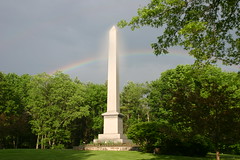A stream ran through it
Across the street, east from the Deuel Cabin, just to the north of the west entrance to Temple Square, is an archway built into the lower part of the wall that surrounds Temple Square. This marks the place where water diverted from City Creek exited Temple Square.
Closeup of City Creek arch in Temple Square wall • Kathie and W. Jeffrey Marsh
When construction began on the Salt Lake Temple and the tabernacle, the pioneers redirected some of City Creek to flow through Temple Square.
A legend evolved stating that for a short time after the Tabernacle was completed, a water wheel was placed in the creek to help pump air into the magnificent Tabernacle organ, but no evidence has been found documenting the use of a waterwheel to power the Tabernacle organ. The organ pump had to be worked by hand until the advent of electricity.
In 1914 City Creek was moved underground along North Temple Street, where it flowed west to the Jordan River, which empties into the Great Salt Lake.
In 2000, well water was pumped into a small creek on the north-side of Temple Square to symbolize the original City Creek.
The Historic City Creek Center, south of Temple Square, includes fountains and man-made streams to represent the historic South Fork of City Creek surrounded by approximately six acres of gardens and open space.
___________________________________________________________________
___________________________________________________________________
Brigham Young University Religious Education presents
Hallowed Ground Sacred Journeys
Featuring BYU Religious Educators teaching about sites significant in
The Church of Jesus Christ of Latter-day Saints
For more information, or to visit our interactive web site with dozens of additional sites to explore,
please visit VirtualTours.BYU.edu
Hallowed Ground Sacred Journeys
is a co-production of
This blog is a public service of The Watchmen Institute
and is distributed by B.U.M.P. LTD.
All Rights Reserved


0 comments:
Post a Comment